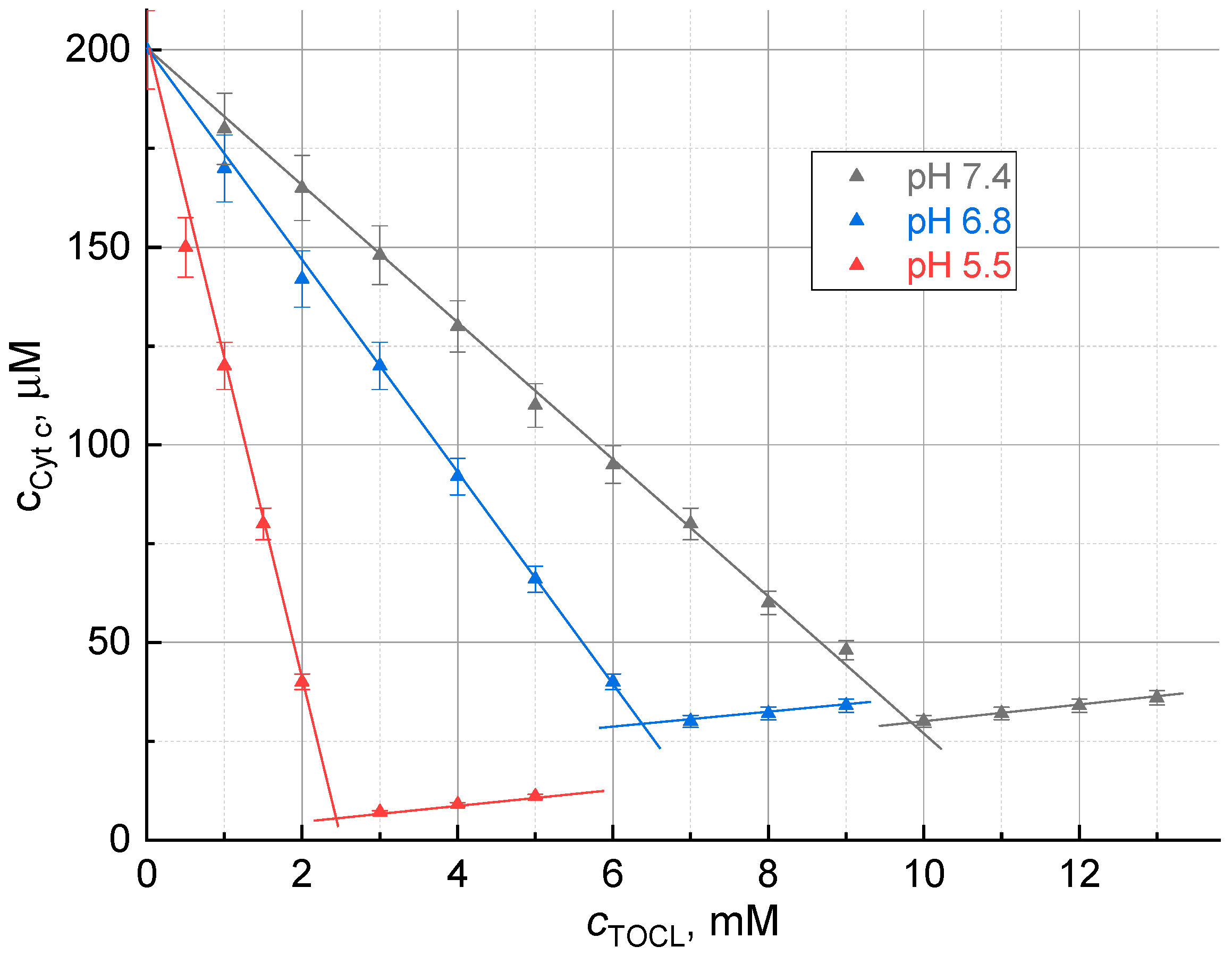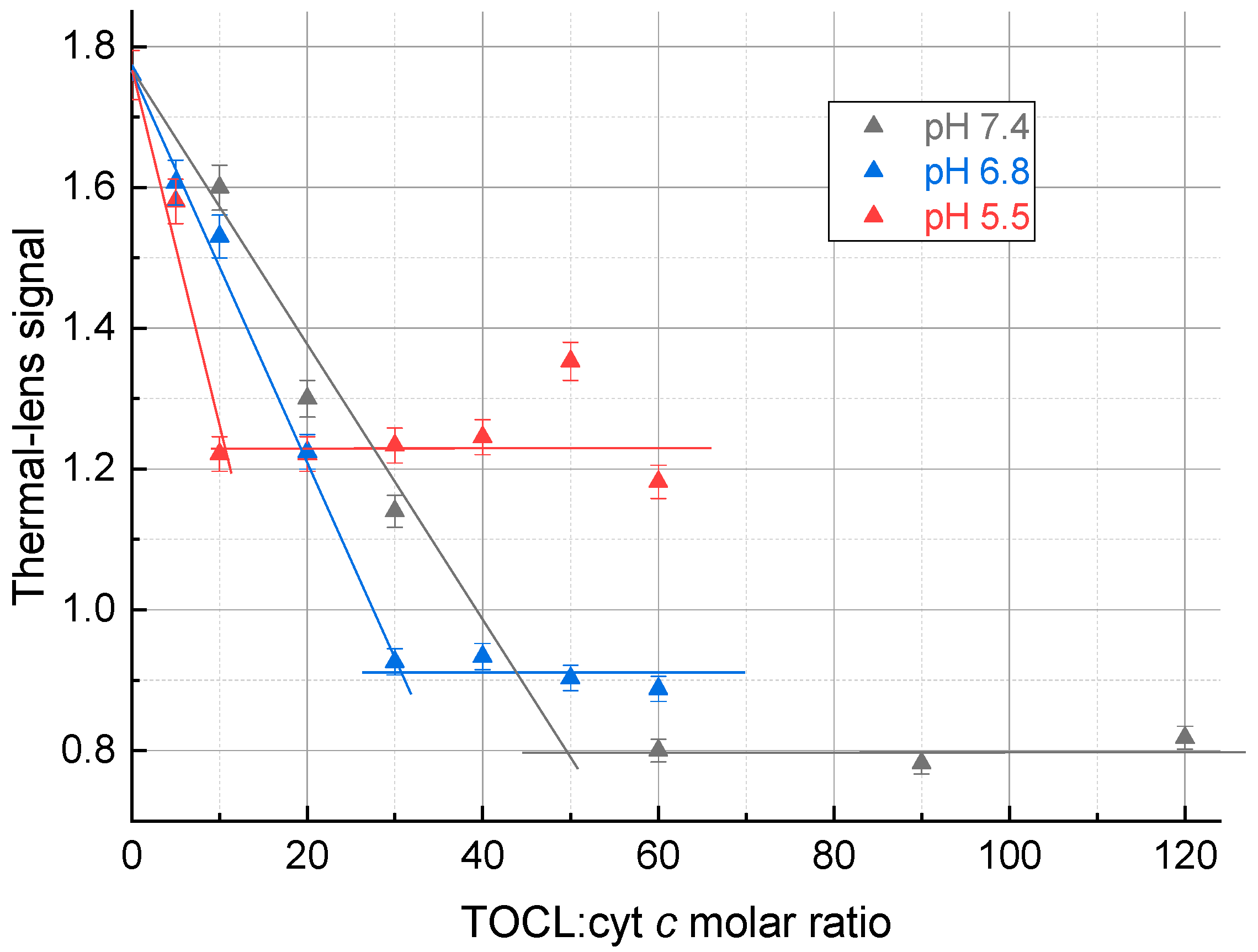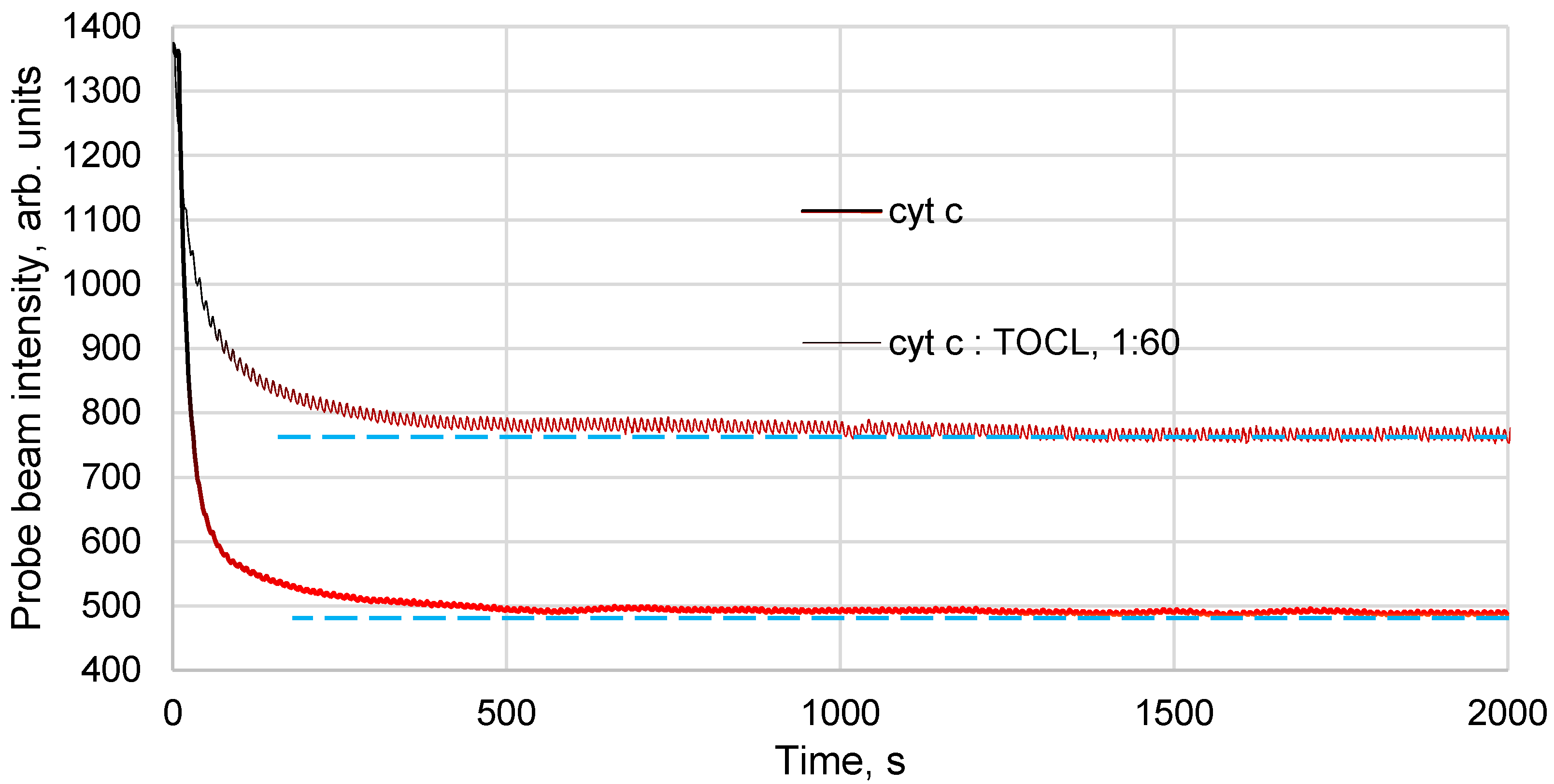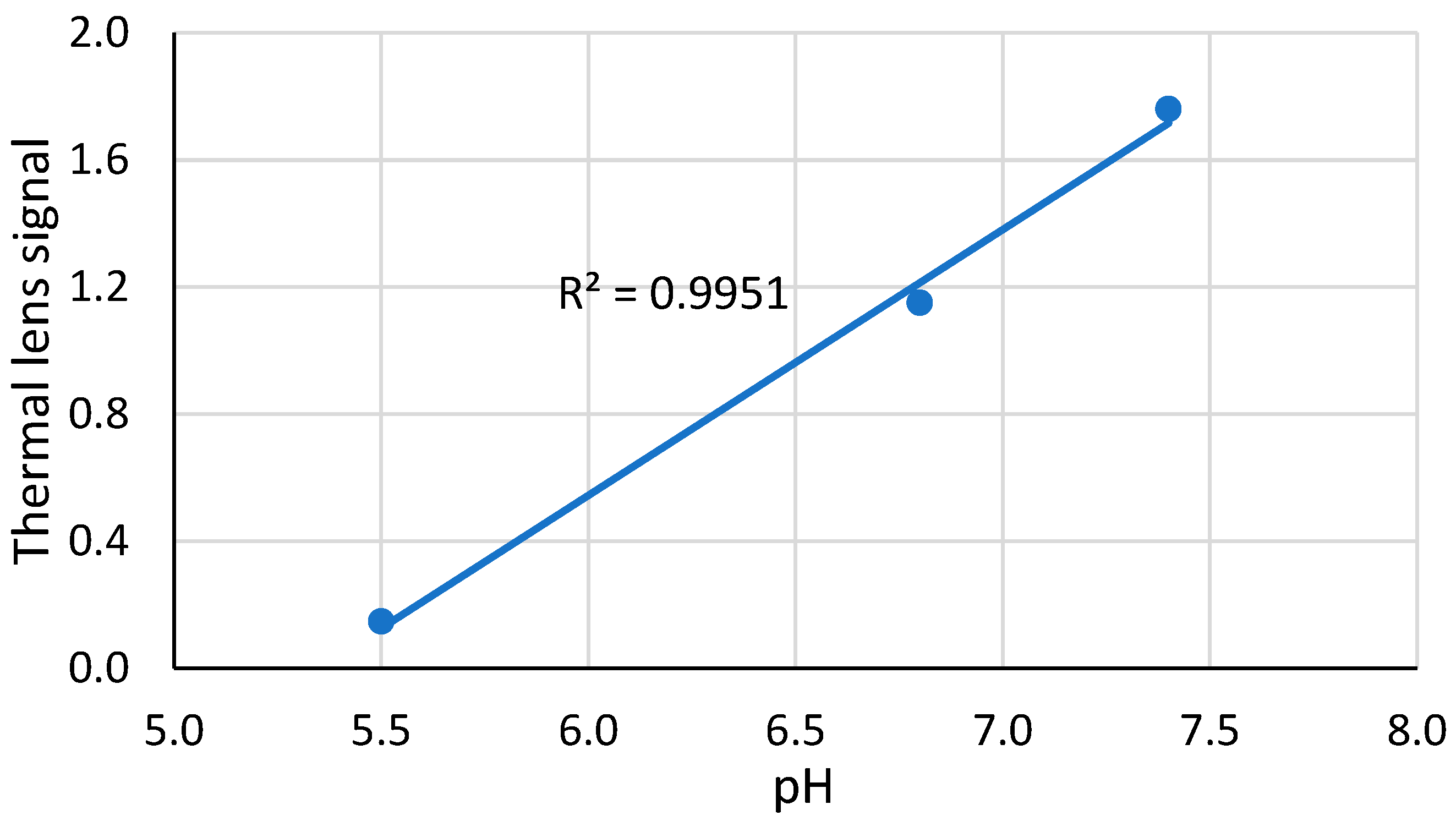Composition of the Cytochrome c Complex with Cardiolipin by Thermal Lens Spectrometry
Abstract
1. Introduction
2. Results
2.1. Assessment of the Cyt c–TOCL Complex Composition by Spectrophotometric Titration
2.2. Assessment of the Complex Composition by Thermal Lens Spectrometry
3. Discussion
4. Materials and Methods
4.1. Reagents and Instrumentation
4.2. Procedures
4.2.1. Spectrophotometry
4.2.2. Thermal Lensing
4.3. Thermal Lens Measurements
5. Conclusions
Author Contributions
Funding
Institutional Review Board Statement
Informed Consent Statement
Data Availability Statement
Acknowledgments
Conflicts of Interest
References
- Diaz-Quintana, A.; Perez-Mejias, G.; Guerra-Castellano, A.; De la Rosa, M.A.; Diaz-Moreno, I. Wheel and Deal in the Mitochondrial Inner Membranes: The Tale of Cytochrome c and Cardiolipin. Oxid. Med. Cell. Longev. 2020, 2020, 6813405. [Google Scholar] [CrossRef]
- Kitt, J.P.; Bryce, D.A.; Minteer, S.D.; Harris, J.M. Raman Spectroscopy Reveals Selective Interactions of Cytochrome c with Cardiolipin That Correlate with Membrane Permeability. J. Am. Chem. Soc. 2017, 139, 3851–3860. [Google Scholar] [CrossRef] [PubMed]
- Vladimirov, Y.A.; Sarisozen, C.; Vladimirov, G.K.; Filipczak, N.; Polimova, A.M.; Torchilin, V.P. The Cytotoxic Action of Cytochrome C/Cardiolipin Nanocomplex (Cyt-CL) on Cancer Cells in Culture. Pharm. Res. 2017, 34, 1264–1275. [Google Scholar] [CrossRef] [PubMed]
- Rice, M.; Wong, B.; Oja, M.; Samuels, K.; Williams, A.K.; Fong, J.; Sapse, A.M.; Maran, U.; Korobkova, E.A. A role of flavonoids in cytochrome c-cardiolipin interactions. Bioorg. Med. Chem. 2021, 33, 116043. [Google Scholar] [CrossRef]
- Kagan, V.E.; Tyurin, V.A.; Jiang, J.; Tyurina, Y.Y.; Ritov, V.B.; Amoscato, A.A.; Osipov, A.N.; Belikova, N.A.; Kapralov, A.A.; Kini, V.; et al. Cytochrome c acts as a cardiolipin oxygenase required for release of proapoptotic factors. Nat. Chem. Biol. 2005, 1, 223–232. [Google Scholar] [CrossRef]
- Kagan, V.E.; Bayir, H.A.; Belikova, N.A.; Kapralov, O.; Tyurina, Y.Y.; Tyurin, V.A.; Jiang, J.; Stoyanovsky, D.A.; Wipf, P.; Kochanek, P.M.; et al. Cytochrome c/cardiolipin relations in mitochondria: A kiss of death. Free Radic. Biol. Med. 2009, 46, 1439–1453. [Google Scholar] [CrossRef]
- Ripanti, F.; Di Venere, A.; Guidi, M.C.; Romani, M.; Filabozzi, A.; Carbonaro, M.; Piro, M.C.; Sinibaldi, F.; Nucara, A.; Mei, G. The Puzzling Problem of Cardiolipin Membrane-Cytochrome c Interactions: A Combined Infrared and Fluorescence Study. Int. J. Mol. Sci. 2021, 22, 1334. [Google Scholar] [CrossRef]
- Zhan, J.; Zhang, G.; Chai, X.; Zhu, Q.; Sun, P.; Jiang, B.; Zhou, X.; Zhang, X.; Liu, M. NMR Reveals the Conformational Changes of Cytochrome C upon Interaction with Cardiolipin. Life 2021, 11, 1031. [Google Scholar] [CrossRef]
- Vladimirov, Y.A.; Proskurnina, E.V.; Izmailov, D.Y.; Novikov, A.A.; Brusnichkin, A.V.; Osipov, A.N.; Kagan, V.E. Cardiolipin activates cytochrome c peroxidase activity since it facilitates H(2)O(2) access to heme. Biochem. Biokhimiia 2006, 71, 998–1005. [Google Scholar] [CrossRef] [PubMed]
- Belikova, N.A.; Vladimirov, Y.A.; Osipov, A.N.; Kapralov, A.A.; Tyurin, V.A.; Potapovich, M.V.; Basova, L.V.; Peterson, J.; Kurnikov, I.V.; Kagan, V.E. Peroxidase activity and structural transitions of cytochrome c bound to cardiolipin-containing membranes. Biochemistry 2006, 45, 4998–5009. [Google Scholar] [CrossRef]
- Vladimirov, Y.A.; Demin, E.M.; Proskurnina, E.V.; Osipov, A.N. Lipoperoxide radical production during oxidation of cardiolipin in the complex with cytochrome c. Biochem. Suppl. Ser. A Membr. Cell Biol. 2009, 4, 479–489. [Google Scholar]
- Thong, A.; Tsoukanova, V. Cytochrome-c-assisted escape of cardiolipin from a model mitochondrial membrane. Biochim. Biophys. Acta Biomembr. 2018, 1860, 475–480. [Google Scholar] [CrossRef] [PubMed]
- Pinto, I.F.D.; Chaves-Filho, A.B.; Cunha, D.D.; Miyamoto, S. Cytochrome c modification and oligomerization induced by cardiolipin hydroperoxides in a membrane mimetic model. Arch Biochem. Biophys. 2020, 693, 108568. [Google Scholar] [CrossRef]
- Vladimirov, Y.A.; Proskurnina, E.V.; Alekseev, A.V. Molecular mechanisms of apoptosis. structure of cytochrome c-cardiolipin complex. Biochem. Biokhimiia 2013, 78, 1086–1097. [Google Scholar] [CrossRef]
- Vladimirov, Y.A.; Nol’, Y.T.; Volkov, V.V. Protein-Lipid Nanoparticles That Determine Whether Cells will Live or Die. Crystallogr. Rep. 2011, 56, 553–559. [Google Scholar] [CrossRef]
- Vikulina, A.S.; Alekseev, A.V.; Proskurnina, E.V.; Vladimirov, Y.A. Cytochrome c-Cardiolipin Complex in a Nonpolar Environment. Biochem. Biokhimiia 2015, 80, 1298–1302. [Google Scholar] [CrossRef]
- Vladimirov, G.K.; Remenshchikov, V.E.; Nesterova, A.M.; Volkov, V.V.; Vladimirov, Y.A. Comparison of the Size and Properties of the Cytochrome c/Cardiolipin Nanospheres in a Sediment and Non-polar Medium. Biochem. Biokhimiia 2019, 84, 923–930. [Google Scholar] [CrossRef] [PubMed]
- Vladimirov, G.K.; Vikulina, A.S.; Volodkin, D.; Vladimirov, Y.A. Structure of the complex of cytochrome c with cardiolipin in non-polar environment. Chem. Phys. Lipids 2018, 214, 35–45. [Google Scholar] [CrossRef]
- Elmer-Dixon, M.M.; Bowler, B.E. Site A-Mediated Partial Unfolding of Cytochrome c on Cardiolipin Vesicles Is Species-Dependent and Does Not Require Lys72. Biochemistry 2017, 56, 4830–4839. [Google Scholar] [CrossRef] [PubMed]
- Kawai, C.; Prado, F.M.; Nunes, G.L.; Di Mascio, P.; Carmona-Ribeiro, A.M.; Nantes, I.L. pH-Dependent interaction of cytochrome c with mitochondrial mimetic membranes: The role of an array of positively charged amino acids. J. Biol. Chem. 2005, 280, 34709–34717. [Google Scholar] [CrossRef]
- Elmer-Dixon, M.M.; Bowler, B.E. Electrostatic Constituents of the Interaction of Cardiolipin with Site A of Cytochrome c. Biochemistry 2018, 57, 5683–5695. [Google Scholar] [CrossRef] [PubMed]
- Paradisi, A.; Bellei, M.; Paltrinieri, L.; Bortolotti, C.A.; Di Rocco, G.; Ranieri, A.; Borsari, M.; Sola, M.; Battistuzzi, G. Binding of S. cerevisiae iso-1 cytochrome c and its surface lysine-to-alanine variants to cardiolipin: Charge effects and the role of the lipid to protein ratio. J. Biol. Inorg. Chem. 2020, 25, 467–487. [Google Scholar] [CrossRef] [PubMed]
- Mohammadyani, D.; Yanamala, N.; Samhan-Arias, A.K.; Kapralov, A.A.; Stepanov, G.; Nuar, N.; Planas-Iglesias, J.; Sanghera, N.; Kagan, V.E.; Klein-Seetharaman, J. Structural characterization of cardiolipin-driven activation of cytochrome c into a peroxidase and membrane perturbation. Biochim. Biophys. Acta Biomembr. 2018, 1860, 1057–1068. [Google Scholar] [CrossRef] [PubMed]
- Bialkowski, S.E.; Astrath, N.G.C.; Proskurnin, M.A. Photothermal Spectroscopy Methods; Wiley: Hoboken, NJ, USA, 2019; p. 512. [Google Scholar]
- Proskurnin, M.A. Photothermal spectroscopy. In Laser Spectroscopy for Sensing; Baudelet, M., Ed.; Woodhead Publishing Series in Electronic and Optical Materials; Woodhead Publ. Ltd.: Cambridge, UK, 2014; pp. 313–361. [Google Scholar]
- Brusnichkin, A.V.; Nedosekin, D.A.; Galanzha, E.I.; Vladimirov, Y.A.; Shevtsova, E.F.; Proskurnin, M.A.; Zharov, V.P. Ultrasensitive label-free photothermal imaging, spectral identification, and quantification of cytochrome c in mitochondria, live cells, and solutions. J. Biophoton. 2010, 3, 791–806. [Google Scholar] [CrossRef] [PubMed]
- Proskurnin, M.A.; Khabibullin, V.R.; Usoltseva, L.O.; Vyrko, E.A.; Mikheev, I.V.; Volkov, D.S. Photothermal and optoacoustic spectroscopy: State of the art and prospects. Physics-Uspekhi 2022, 65, 270–312. [Google Scholar] [CrossRef]
- Santo-Domingo, J.; Demaurex, N. Perspectives on: SGP symposium on mitochondrial physiology and medicine: The renaissance of mitochondrial pH. J. Gen. Physiol. 2012, 139, 415–423. [Google Scholar] [CrossRef]
- Coletta, M.; Costa, H.; De Sanctis, G.; Neri, F.; Smulevich, G.; Turner, D.L.; Santos, H. pH dependence of structural and functional properties of oxidized cytochrome c" from Methylophilus methylotrophus. J. Biol. Chem. 1997, 272, 24800–24804. [Google Scholar] [CrossRef]
- Babul, J.; Stellwagen, E. Participation of the protein ligands in the folding of cytochrome c. Biochemistry 1972, 11, 1195–1200. [Google Scholar] [CrossRef]
- Mikheev, I.V.; Volkov, D.S.; Proskurnin, M.A.; Korobov, M.V. Monitoring of Aqueous Fullerene Dispersions by Thermal-Lens Spectrometry. Int. J. Thermophys. 2014, 36, 956–966. [Google Scholar] [CrossRef]
- Proskurnin, M.A.; Usoltseva, L.O.; Volkov, D.S.; Nedosekin, D.A.; Korobov, M.V.; Zharov, V.P. Photothermal and Heat-Transfer Properties of Aqueous Detonation Nanodiamonds by Photothermal Microscopy and Transient Spectroscopy. J. Phys. Chem. C 2021, 125, 7808–7823. [Google Scholar] [CrossRef]
- Khabibullin, V.R.; Usoltseva, L.O.; Galkina, P.A.; Galimova, V.R.; Volkov, D.S.; Mikheev, I.V.; Proskurnin, M.A. Photothermal Properties and Measurement Precision of Nanostructures in Aqueous Solutions by Transient and Steady-State Thermal-Lens Spectrometry. Physchem 2023, 3, 156–197. [Google Scholar] [CrossRef]
- Jain, R.; Kumar, R.; Kumar, S.; Chhabra, R.; Agarwal, M.C.; Kumar, R. Analysis of the pH-dependent stability and millisecond folding kinetics of horse cytochrome c. Arch. Biochem. Biophys. 2015, 585, 52–63. [Google Scholar] [CrossRef] [PubMed]
- Wilkinson, J.A.; Silvera, S.; LeBlanc, P.J. The effect of cardiolipin side chain composition on cytochrome c protein conformation and peroxidase activity. Physiol. Rep. 2021, 9, e14772. [Google Scholar] [CrossRef]
- Milorey, B.; Schweitzer-Stenner, R.; Kurbaj, R.; Malyshka, D. pH-Induced Switch between Different Modes of Cytochrome c Binding to Cardiolipin-Containing Liposomes. ACS Omega 2019, 4, 1386–1400. [Google Scholar] [CrossRef]
- Pandiscia, L.A.; Schweitzer-Stenner, R. Salt as a catalyst in the mitochondria: Returning cytochrome c to its native state after it misfolds on the surface of cardiolipin containing membranes. Chem. Commun. 2014, 50, 3674–3676. [Google Scholar] [CrossRef]
- Oellerich, S.; Lecomte, S.; Paternostre, M.; Heimburg, T.; Hildebrandt, P. Peripheral and Integral Binding of Cytochrome c to Phospholipids Vesicles. J. Phys. Chem. B. 2004, 108, 3871–3878. [Google Scholar] [CrossRef]
- Kuroda, Y.; Kidokoro, S.; Wada, A. Thermodynamic characterization of cytochrome c at low pH. Observation of the molten globule state and of the cold denaturation process. J. Mol. Biol. 1992, 223, 1139–1153. [Google Scholar] [CrossRef]
- Battistuzzi, G.; Bortolotti, C.A.; Bellei, M.; Di Rocco, G.; Salewski, J.; Hildebrandt, P.; Sola, M. Role of Met80 and Tyr67 in the low-pH conformational equilibria of cytochrome c. Biochemistry 2012, 51, 5967–5978. [Google Scholar] [CrossRef] [PubMed]
- Haines, H. A new look at Cardiolipin. Biochim. Biophys. Acta 2009, 1788, 1997–2002. [Google Scholar] [CrossRef]
- Olofsson, G.; Sparr, E. Ionization constants pKa of cardiolipin. PLoS ONE 2013, 8, e73040. [Google Scholar] [CrossRef]
- Parui, P.P.; Sarakar, Y.; Majumder, R.; Das, S.; Yang, H.; Yasuhara, K.; Hirota, S. Determination of proton concentration at cardiolipin-containing membrane interfaces and its relation with the peroxidase activity of cytochrome c. Chem. Sci. 2019, 10, 9140–9151. [Google Scholar] [CrossRef]
- Brown, L.R.; Wuthrich, K. NMR and ESR studies of the interactions of cytochrome c with mixed cardiolipin-phosphatidylcholine vesicles. Biochim. Biophys. Acta 1977, 468, 389–410. [Google Scholar] [CrossRef]
- Pinheiro, T.J.; Cheng, H.; Seeholzer, S.H.; Roder, H. Direct evidence for the cooperative unfolding of cytochrome c in lipid membranes from H-(2)H exchange kinetics. J. Mol. Biol. 2000, 303, 617–626. [Google Scholar] [CrossRef] [PubMed]
- Muenzner, J.; Pletneva, E. Structural Transformations of Cytochrome c upon Interaction with Cardiolipin. Chem. Phys. Lipids 2013, 179, 57–63. [Google Scholar] [CrossRef] [PubMed]
- Hong, Y.; Muenzner, J.; Grimm, S.K.; Pletneva, E.V. Origin of the conformational heterogeneity of cardiolipin-bound cytochrome C. J. Am. Chem. Soc. 2012, 134, 18713–18723. [Google Scholar] [CrossRef]
- Gorbenko, G.P.; Molotkovsky, J.G.; Kinnunen, P.K. Cytochrome C interaction with cardiolipin/phosphatidylcholine model membranes: Effect of cardiolipin protonation. Biophys. J. 2006, 90, 4093–4103. [Google Scholar] [CrossRef]
- Domanov, Y.A.; Molotkovsky, J.G.; Gorbenko, G.P. Coverage-dependent changes of cytochrome c transverse location in phospholipid membranes revealed by FRET. Biochim. Biophys. Acta 2005, 1716, 49–58. [Google Scholar] [CrossRef] [PubMed]
- Beales, P.A.; Bergstrom, C.L.; Geerts, N.; Groves, J.T.; Vanderlick, T.K. Single vesicle observations of the cardiolipin-cytochrome C interaction: Induction of membrane morphology changes. Langmuir 2011, 27, 6107–6115. [Google Scholar] [CrossRef]
- Li, M.; Mandal, A.; Tyurin, V.A.; DeLucia, M.; Ahn, J.; Kagan, V.E.; van der Wel, P.C.A. Surface-Binding to Cardiolipin Nanodomains Triggers Cytochrome c Pro-apoptotic Peroxidase Activity via Localized Dynamics. Structure 2019, 27, 806–815.e804. [Google Scholar] [CrossRef] [PubMed]
- Gohil, V.M.; Greenberg, M.L. Mitochondrial membrane biogenesis: Phospholipids and proteins go hand in hand. J. Cell. Biol. 2009, 184, 469–472. [Google Scholar] [CrossRef]
- Zinser, E.; Sperka-Gottlieb, C.D.; Fasch, E.V.; Kohlwein, S.D.; Paltauf, F.; Daum, G. Phospholipid synthesis and lipid composition of subcellular membranes in the unicellular eukaryote Saccharomyces cerevisiae. J. Bacteriol. 1991, 173, 2026–2034. [Google Scholar] [CrossRef]
- Fukuzawa, K.; Iemura, M.; Tokumura, A. Lipid peroxidation in egg phosphatidylcholine liposomes: Comparative studies on the induction systems Fe2+/ascorbate and Fe(3+)-chelates/xanthine-xanthine oxidase. Biol. Pharm. Bull. 1996, 19, 665–671. [Google Scholar] [CrossRef]
- Chasovnikova, L.V.; Formaziuk, V.E.; Sergienko, V.I.; Vladimirov Iu, A. Peroxidation of phosphatidylcholine and cholesterol in mixed monolayers. Biofizika 1991, 36, 589–593. [Google Scholar] [PubMed]
- van Duijn, G.; Verkleij, A.J.; de Kruijff, B. Influence of phospholipid peroxidation on the phase behavior of phosphatidylcholine and phosphatidylethanolamine in aqueous dispersions. Biochemistry 1984, 23, 4969–4977. [Google Scholar] [CrossRef] [PubMed]
- Kubo, K.; Sekine, S.; Saito, M. Docosahexaenoic acid-containing phosphatidylethanolamine in the external layer of liposomes protects docosahexaenoic acid from 2,2'-azobis(2-aminopropane)dihydrochloride-mediated lipid peroxidation. Arch. Biochem. Biophys. 2003, 410, 141–148. [Google Scholar] [CrossRef]
- Butler, E.S.O.; Mazerik, J.N.; Cruff, J.P.; Sherwani, S.I.; Weis, B.K.; Marsh, C.B.; Raghavamenon, A.C.; Uppu, R.M.; Schmid, H.H.; Parinandi, N.L. Lipoxygenase-catalyzed phospholipid peroxidation: Preparation, purification, and characterization of phosphatidylinositol peroxides. Meth. Mol. Biol. 2010, 610, 387–401. [Google Scholar] [CrossRef]
- Jiang, J.; Serinkan, B.F.; Tyurina, Y.Y.; Borisenko, G.G.; Mi, Z.; Robbins, P.D.; Schroit, A.J.; Kagan, V.E. Peroxidation and externalization of phosphatidylserine associated with release of cytochrome c from mitochondria. Free Radic. Biol. Med. 2003, 35, 814–825. [Google Scholar] [CrossRef]
- Viani, P.; Cervato, G.; Fiorilli, A.; Rigamonti, E.; Cestaro, B. Studies on peroxidation processes of model membranes and synaptosomes: Role of phosphatidic acid. Chem. Phys. Lipids 1990, 52, 49–55. [Google Scholar] [CrossRef] [PubMed]
- Tyurina, Y.Y.; Shvedova, A.A.; Kawai, K.; Tyurin, V.A.; Kommineni, C.; Quinn, P.J.; Schor, N.F.; Fabisiak, J.P.; Kagan, V.E. Phospholipid signaling in apoptosis: Peroxidation and externalization of phosphatidylserine. Toxicology 2000, 148, 93–101. [Google Scholar] [CrossRef]
- Matsura, T.; Serinkan, B.F.; Jiang, J.; Kagan, V.E. Phosphatidylserine peroxidation/externalization during staurosporine-induced apoptosis in HL-60 cells. FEBS Lett. 2002, 524, 25–30. [Google Scholar] [CrossRef]
- Jiang, J.; Kini, V.; Belikova, N.; Serinkan, B.F.; Borisenko, G.G.; Tyurina, Y.Y.; Tyurin, V.A.; Kagan, V.E. Cytochrome c release is required for phosphatidylserine peroxidation during Fas-triggered apoptosis in lung epithelial A549 cells. Lipids 2004, 39, 1133–1142. [Google Scholar] [CrossRef] [PubMed]
- Khabibullin, V.R.; Franko, M.; Proskurnin, M.A. Accuracy of Measurements of Thermophysical Parameters by Dual-Beam Thermal-Lens Spectrometry. Nanomaterials 2023, 13, 430. [Google Scholar] [CrossRef] [PubMed]
- Shen, J.; Lowe, R.D.; Snook, R.D. A model for cw laser-induced mode-mismatched dual-beam thermal lens spectrometry. Chem. Phys. 1992, 165, 385–396. [Google Scholar] [CrossRef]
- Baesso, M.L.; Shen, J.; Snook, R.D. Time-resolved thermal lens measurement of thermal diffusivity of soda—Lime glass. Chem. Phys. Lett. 1992, 197, 255–258. [Google Scholar] [CrossRef]





| Buffer Solution | KH2PO4, 20 mM | Phthalate, 20 mM | |||
|---|---|---|---|---|---|
| pH | 7.4 | 6.8 | 5.5 | 4.1 | 3.7 |
| TOCL: Cyt c molar ratio | 50 ± 7 | 33 ± 5 | 13 ± 3 | 14 ± 3 | 13 ± 4 |
| S, μmol/L | 31 ± 4 | 32 ± 4 | 11 ± 3 | n/a | n/a |
| pH | 7.4 | 6.8 | 5.5 |
|---|---|---|---|
| TOCL:Cyt c molar ratio | 50 ± 4 | 30 ± 4 | 10 ± 4 |
| Excitation Ar+ laser Innova 90-6 | Wavelength, λe (nm) | 514.5 |
| Power range at the sample (TEM00 mode), Pe (mW) | 1–200 | |
| Waist radius (µm) | 55 ± 3 | |
| Focal distance of the focusing lens (mm) | 300 | |
| Probe He–Ne laser HRP020 | Wavelength, λp (nm) | 632.8 |
| Power range at the sample (TEM00 mode), Pp (mW) | 2 | |
| Waist radius (µm) | 25.0 | |
| Focal distance of the focusing lens (mm) | 185 | |
| Other parameters | Sample optical path l (mm) | 2.0 |
| Shutter rate (Hz) | 0.5–4 | |
| Geometry constant B (Equation (2)) | 0.378 |
Disclaimer/Publisher’s Note: The statements, opinions and data contained in all publications are solely those of the individual author(s) and contributor(s) and not of MDPI and/or the editor(s). MDPI and/or the editor(s) disclaim responsibility for any injury to people or property resulting from any ideas, methods, instructions or products referred to in the content. |
© 2023 by the authors. Licensee MDPI, Basel, Switzerland. This article is an open access article distributed under the terms and conditions of the Creative Commons Attribution (CC BY) license (https://creativecommons.org/licenses/by/4.0/).
Share and Cite
Proskurnin, M.A.; Proskurnina, E.V.; Galimova, V.R.; Alekseev, A.V.; Mikheev, I.V.; Vladimirov, Y.A. Composition of the Cytochrome c Complex with Cardiolipin by Thermal Lens Spectrometry. Molecules 2023, 28, 2692. https://doi.org/10.3390/molecules28062692
Proskurnin MA, Proskurnina EV, Galimova VR, Alekseev AV, Mikheev IV, Vladimirov YA. Composition of the Cytochrome c Complex with Cardiolipin by Thermal Lens Spectrometry. Molecules. 2023; 28(6):2692. https://doi.org/10.3390/molecules28062692
Chicago/Turabian StyleProskurnin, Mikhail A., Elena V. Proskurnina, Viktoriya R. Galimova, Andrei V. Alekseev, Ivan V. Mikheev, and Yuri A. Vladimirov. 2023. "Composition of the Cytochrome c Complex with Cardiolipin by Thermal Lens Spectrometry" Molecules 28, no. 6: 2692. https://doi.org/10.3390/molecules28062692
APA StyleProskurnin, M. A., Proskurnina, E. V., Galimova, V. R., Alekseev, A. V., Mikheev, I. V., & Vladimirov, Y. A. (2023). Composition of the Cytochrome c Complex with Cardiolipin by Thermal Lens Spectrometry. Molecules, 28(6), 2692. https://doi.org/10.3390/molecules28062692






